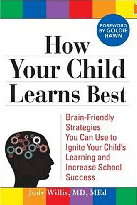We’ve Got Issues-
November 10, 2017 · Posted in ADHD, Children's Therapy, Learning Issues · 1 Comment
We’ve Got Issues-
Children and Parents in the Age of Medication
-by Judith Warner
In this manifesto for change, New York Times blogger Judith Warner (Perfect Madness: Motherhood in the Age of Anxiety, 2005, etc.) examines the argument that Americans are overmedicating their children.
The author wanted to write a condemnation of American parents for hysterically spotting mental disorders where there are none. When she began interviewing parents and mental-health professionals, however, she reversed her position. Only five percent of American children take psychotropic drugs, she writes, yet that many suffer from extreme mental illness, while another 15 percent endure at least minimal illness. Not only has Warner never met a parent who lunged for the medicine cabinet to dope up their kids, but some fought the medication route as long as they could, to the detriment of their child. It’s true that antidepressant prescriptions for children have skyrocketed, but that’s because primitive understanding of the brain left many sick children undiagnosed in the past; we now have more effective drugs for some illnesses; and the stigma of mental illness is blessedly diminished. Warner cites research that girls, minority children and those with less-educated parents are undertreated for ADHD. Careful reporter that she is, the author acknowledges that some experts might dispute parts of her thesis. Other signs of childhood trauma-teen pregnancy, school violence, crime, substance abuse and suicide-have declined, and Warner reports special professional skepticism about exploding rates of bipolar diagnoses in children. Meanwhile, too many laypeople are spooked by drug companies’ ads plugging their latest products, which doctors might not recommend. Curtailing those ads and more insurance coverage for pediatric mental-health screenings are among the author’s welcome common-sense proposals.

Parents of mentally ill children will find this tonic reassuring, while all parents will find it a valuable reminder that it’s not poor parenting to seek medical help for your children.
-Kirkus
Hardcover: 336 pages; Publisher: Riverhead Hardcover (February 23, 2010)
ISBN-10: 1594487545
Studying for the Test by Taking It
November 10, 2017 · Posted in Evaluation, Learning Issues, SAT, Trouble Learning · Comment
A version of this article appeared in print on November 22, 2014, in the New York Times.
PROTESTS are flaring up in pockets of the country against the proliferation of standardized tests. For many parents and teachers, school has become little more than a series of workout sessions for the assessment du jour.
And that is exactly backward, research shows. Tests should work for the student, not the other way around.
In an experiment published late last year, two University of Texas psychologists threw out the final exam for the 900 students in their intro psych course and replaced it with a series of short quizzes that students took on their laptops at the beginning of each class.
“They didn’t like it, at least at first,” said one of the professors, James W. Pennebaker. The other professor, Samuel D. Gosling, added, “For the first few weeks, every time their friends went out drinking, they couldn’t go — they had yet another quiz the next day.”
But they did significantly better than a comparison intro psych class, both in their grades and on a larger quiz that included 17 of the same questions that appeared both in the quizzes and on the other class’s midterm. The quizzes were especially beneficial for the type of students — many from low-performing high schools — who don’t realize how far behind they are until it’s too late.
One leading researcher in this field, Henry L. Roediger III of Washington University in St. Louis, argues that tests of varying scale and intensity can deepen learning. “We now know that testing, including self-testing, is an especially powerful form of study,” said Dr. Roediger, co-author of the book “Make It Stick.”
How so? Because retrieving facts, formulas or concepts is a threefold mental act: finding the sought-after information in the vast catacombs of the brain; bringing it consciously to mind; and finally, storing it. That newly stored memory will be embedded in a host of additional associations and connections and be much easier to recall later than if you’d merely read it again.
Testing has so many dimensions that it can often be easily disguised. In a study published last month, the cognitive scientist Doug Rohrer of the University of South Florida made a clever change in the math homework of middle school students in Tampa, Fla. Working with teachers, he essentially gave each student two types of assignments. To test some skills they got so-called blocked practice — concentrated drills on a single thing, like solving for X. On other skills they got mixed practice, that is, blending certain skills — say graphing — with other types of problems from the course.
The rationale was straightforward. Practicing skills in isolation leads to noticeable improvement, but students do not have to shift gears. They know how to proceed because the assignment says “graphs” or “solving for X” at the top of the page.
Yet at the end of the term, on a surprise test, the students solved 72 percent of the problems that they’d studied in mixed sets, compared with 38 percent of those in blocked, homework-as-usual sets. The problems and teachers were the same, and the classes were taught as usual. The only change was in the homework.
In the jargon of the field, this strategy of mixed problem-sets is called interleaving. It is distinct from the end-of-unit reviews that teachers commonly give, because it’s self-guided and continual. It mimics a test in a crucial way, in that it forces students to distinguish between types of problems and decide which strategy is appropriate.
The beauty of broadening testing beyond basic assessment is that the approach can be applied at home, easily, for students of all ages. Most young children squirm through their homework, but many love to play teacher. By cutting short “study time” and asking them to be the teacher, parents can make the session more fun, more interactive and a richer learning experience. Teaching is self-testing of an especially potent kind.
Ditto for making an outline of a chapter (with the book closed), or discussing the material with a friend or roommate. One reason scientists suspect that studying in pairs or groups can be helpful is that students are forced to talk to one another about the material — or better yet, argue about it. These are all forms of self-examination, and as such deepen learning more than passively rereading or reviewing the material.
The brain is an exotic learning machine, to put it mildly. It does not take orders well. You can tell it to remember the major players in the settling of Manhattan, stress how crucially important that is, and on the test a week later very little comes back. And yet you might remember nearly every play in the San Francisco Giants’ Game 7 World Series victory. Why? Because the brain doesn’t listen to what you say; it watches what you do. And thinking often about Madison Bumgarner pitching, talking about the game, arguing about it: These are mental actions, as well as subtle forms of testing knowledge.
Testing in all its permutations, subtle and otherwise, convinces the brain that the knowledge is useful, and important. And by varying one’s testing strategies, the actual final exam — the dreaded assessment — isn’t nearly as scary.
Benedict Carey is a science reporter for The New York Times and the author of “How We Learn: The Surprising Truth About When, Where, and Why It Happens.”
How Your Child Learns Best
Friendly Strategies You Can Use to Ignite Your Child’s Learning and Increase School Success
-by Judy Willis, MD, M. Ed
A groundbreaking guide for parents that combines the latest brain research with the best classroom practices to reveal scientifically savvy ways to improve your child’s success in school.
Written by Judy Willis, MD, MEd, a board-certified neurologist who is also a full-time classroom teacher, How Your Child Learns Best shows you not only how to help your child learn schoolwork, but also how to capitalize on the way your child’s brain learns best in order to enrich education wherever you are, from the grocery store to the car – a necessity in today’s “teach to the test” world.

By using everyday household items and enjoyable activities, parents of children ages three to twelve can apply targeted strategies (based on age and learning strength) in key academic areas, including:
• Reading comprehension
• Math word problems
• Test preparation
• Fractions and decimals
• Oral reading
• Reports and projects
• Science and history
• Reading motivation
• Vocabulary
Discover how to help your child increase academic focus and success, lower test stress while increasing test scores, increase class participation, foster creativity, and improve attention span, memory, and higher-level thinking.
Paperback: 336 pages; Publisher: Sourcebooks, Inc. (September 1, 2008)
ISBN-10: 1402213468 ISBN-13: 978-1402213465
College Board Changes Affect Students with Learning Disabilities
Parents take note: Back in September 2003, two important changes by The College Board, which provides the SAT as well as the PSAT and AP tests, took effect changing how colleges view students with learning disabilities.
First any students who take the SAT’s (Scholastic Aptitude Test) with testing accommodations, such as extended time, will no longer have their scores “flagged” for colleges indicating that the “scores were obtained under special conditions”.
The admirable idea is to create a level playing field for those students with learning disabilities and prevent colleges from discriminating against them. Accommodations are granted to those students with learning disabilities who demonstrate a need based on psycho-educational testing and teachers input. A learning disability is defined as a significant discrepancy between a child’s ability (or IQ) and his school performance. Such students may need a little extra time on tests, not because they’re not as bright as other students, but because their brains process information differently. Many children receive some accommodations throughout their academic careers. Often this makes the difference between frustrated, under performing children with low self esteem and well adjusted, happy, high performing ones.
This change is great news and long overdue for students with learning disabilities, which make up 6% of the national student population. At present only 2% of students seek test accommodations from the College Board. This low number may be partially due to concerns about the past flagging of scores and fears that schools might be hesitant to accept them. Now perhaps more students with learning disabilities will request and receive proper and appropriate SAT accommodations.
The second important change concerns how such accommodations are granted. Comprehensive psycho-educational evaluations older than 5 years will no longer be accepted. On the national level, public and private primary grade schools use varying criteria for assessing and granting accommodations to students. One such accommodation is called a 504 which is given to students who do not fit the classification of Special Education, but have learning difficulties and therefore receive some modifications in their school program. These modifications can include extended time for testing, a structured learning environment, modified homework or any other modification that will help the student to succeed.
But the College Board exams are all nationally standardized and therefore eligibility for accommodations must also be nationally standardized. Students who have been receiving accommodations at their school for less than 4 months will not be eligible to receive test accommodations on the SAT. They can however go through the SAT Appeal Process and challenge it. Even students with long term accommodations at their school are not guaranteed accommodations for the SAT. All students requesting accommodations for the SAT must submit documentation to the College Board at least 5 weeks prior to the SAT test date and for those going through the Appeal Process a minimum of 7 weeks is needed.
Documentation required for SAT testing accommodations must: 1) State the specific disability; 2) Be current (within three years; one year for psychiatric disability); 3) Provide relevant educational, developmental and medical history; 4) Describe the comprehensive testing and techniques used to arrive at the diagnosis (including evaluation dates and test results with subtest scores from measures of cognitive ability, academic achievement, and information processing); 5) describe the functional limitations supported by the test results; 6) Describe the specific accommodations requested; and 7) Establish the professional credentials of the evaluator, including information about license or certification and area of specialization.
For more info visit: www.collegeboard.com/ssd/

